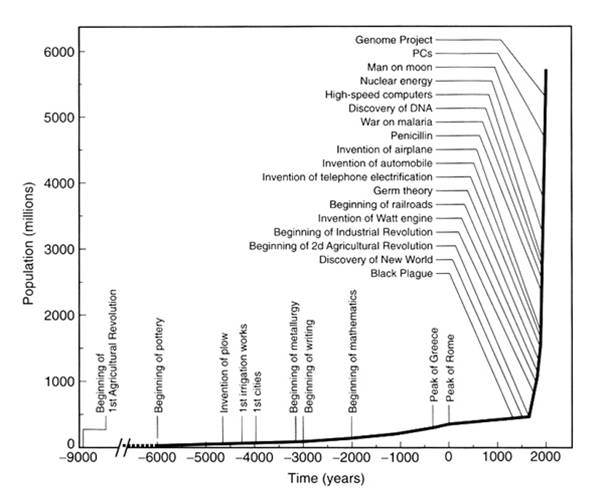Lesson 1: Economic Growth and Scarcity

- >
- Teachers
- >
- Teacher Resources
- >
- Lesson Plans
- >
- Economics for Leaders
- >
- Lesson 1: Economic Growth and …
Download EFL Lesson 1 Guide
EFL Lesson 1 Slides
Introduction
In this lesson students are introduced to the concept of economic growth through the story of human progress and changing standards of living over time. Video clips, historical examples and a mini-activity engage students in the discovery of the institutions that foster economic growth.
Mini Activity
- “Incentives Matter – Rice Pick-up”
Objectives
At the end of this lesson students will be able to:
- Explain the relationship between scarcity and choice.
- Define Economic Growth
- Identify institutions that foster economic growth.
Economic Concepts
| Scarcity | Incentives | Technological change |
| Standard of living | Economic growth | Productivity |
National Content Standards Addressed
Standard 1: Scarcity
Productive resources are limited. Therefore people cannot have all the goods and services they want. As a result, they must choose some things and give up others.
- Like individuals, governments and societies experience scarcity because human wants exceed what can be made from all available resources.
- Choices involve trading off the expected value of one opportunity against the expected value of its best alternative.
- The choices people make have both present and future consequences.
- The evaluation of choices and opportunity costs is subjective; such evaluations differ across individuals and societies.
Standard 4: Incentives
People respond predictably to positive and negative incentives.
- Rewards are positive incentives that make people better off.
- Penalties are negative incentives that make people worse off.
Standard 15: Growth
Investment in factories, machinery, new technology, and in the health, education, and training of people can raise future standards of living.
- Economic growth is a sustained rise in a nation’s production of goods and services. It results from investments in human and physical capital, research and development, technological change, and improved institutional arrangements and incentives.
- Historically, economic growth has been the primary vehicle for alleviating poverty and raising standards of living around the world.
- Differences in economic growth are explained by differences in institutional arrangements, incentives to invest and the openness of markets to trade.
Key Ideas
Download full lesson guide for procedures and teaching tips.
- Scarcity – the condition we face with limited resources to satisfy unlimited wants, which compels us to choose among alternatives.
- Economic growth raises standards of living, even in the continuing face of scarcity.
- The history of world economic growth raises important questions about the ability of nations to deal with the ever-present problem of scarcity:
- Why are some countries rich and others poor? The cross-sectional evidence shows a fairly wide disparity in per capita income between countries.
- Why have some countries experienced economic growth and others have not? That is, looking back over a country’s history, what factors have led to economic growth?
- Why are some countries growing rapidly today and others are not, even though they may have experienced significant growth in the past?
- What can be done to promote economic growth and reduce poverty?
- Economic growth is a sustained increase in a nation’s production of goods and services.
- Increases in productivity, as the result of investments in human and physical capital, raise incomes and standards of living.
- Innovation, technological advances, and education are the major sources of increases in productivity.
Figure 1 – population and innovation graph (Fogel)

- Institutions matter for economic growth. Nations that experience economic growth have established institutions that provide incentives for innovation and technological advance. Nations with stagnant economies where poverty persists lack the institutional incentives that encourage growth and increases in productivity.
- Institutional arrangements define the formal and informal rules of the game that govern how people interact. These arrangements shape incentives and outline expected and acceptable forms of behavior in social interaction.
- The institutions that foster growth and economic development include:
- Open Markets – “Trade creates wealth.”
- Property Rights – “Rights of ownership facilitate exchange.”
- Rule of Law – “Consistent legal arrangements applied uniformly encourage long-term investment.”
- Entrepreneurship and Innovation – “Increasing the gains from creative endeavors adds to economic activity.”
- Economic growth creates benefits throughout the economy.
- Economic growth expands a nation’s productive capacity.
- Historically, all segments of the economy have benefited from economic growth; hence the rise of the middle class.
Ideas To Take Away From This Lesson
- Scarcity forces us to choose among alternatives.
- Economic growth gives us more to choose from, and raises standards of living.
- Certain institutions and institutional arrangements encourage economic growth and this growth improves the human condition, by reducing infant mortality, lengthening lives, reducing hunger, improving environmental quality, cutting the incidence of debilitating diseases, etc.
- Lesson 1: Economic Growth and Scarcity
- Lesson 2: Opportunity Cost and Incentives
- Lesson 3: Open Markets
- Lesson 4: Markets in Action
- Lesson 5: Labor Markets
- Lesson 6: Incentives, Innovations, and Roles of Institutions
- Lesson 7: Property Rights: Is the Environment Different?
- Lesson 8: Setting the Rules: Costs and Benefits of Government Action
- Lesson 9: Money and Inflation
- Lesson 10: International Markets
- The Magic of Markets – Trade Creates Wealth
- In the Chips — A Market in Computer Chips
- The Job Jungle: A Labor Market Game*
- Cartels and Competition
- The Wheat Activity
- The Fish Game
- Farmers and Fishers
- A Pollution Solution
- Foreign Currency and Foreign Exchange

From Student to Leader: Bret’s Transformative Experience at the EFL Program at UC Berkeley
November 13, 2025 Bret Chen had always been drawn to the world of business. As a high school junior from…

Aditi Gandhi: Economics for Leaders Virtual Program Alumni
October 6, 2025 Aditi sat at her desk in Dubai, staring at her computer screen, her fingers hovering over the…

October is National Economic Education Month. We need it more than ever.
The Washington Examiner By Ted Tucker October 2, 2025 A fundamental economic principle is that voluntary trade creates wealth, and the…
